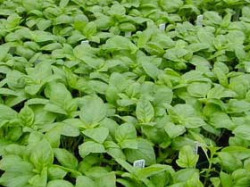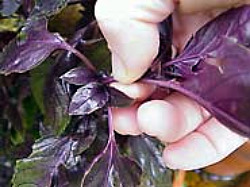Edible of the Month: Basil

Starting basil from seed allows you to grow lots of plants for little cost.
Basil is one of the most popular culinary herbs and is used in cooking around the world. It is very symbolic and has a rich history. In India, where it originated, basil is used in courtrooms where they swear oaths upon it. In Italy is symbolizes love and is often worn in the hair of a romantic suitor. In Greece, where the word basil means “king”, it is considered the king of herbs and is associated with healing powers and is used in baths and for medicine.
Regardless of its history, basil is a mint relative, and is mostly beloved for it culinary properties. Most gardeners know the Italian sweet basil flavor well. It’s used in cooking and is an essential ingredient of pesto. However, there are other types of basil with flavors such as lemon, cinnamon, and anise. It’s a favored herb for ethnic dishes from Mexico to Thailand. Plus, many basil varieties make beautiful ornamental additions to a flower or herb garden. Some have purple leaves, stems, or flowers and some have an attractive globe shape. Whichever basil you’re growing, it makes a perfect candidate for your edible landscape.
Planning
Basil is a warmth loving annual plant. In cold areas it grows best in containers, greenhouses, or raised beds protected from cold winds and soil. It can started from seed sown directly in the ground, or started early indoors and transplanted after the soil has warmed and the danger of frost is past. Plants grow quickly during periods of warm weather, yielding an abundance of leaves for cooking.
Here are some of the best varieties to try in your garden. All grow 18 to 24 inches tall and are used for culinary purposes, unless otherwise noted.
‘Cinnamon’ – This variety from Mexico is more commonly used for decorations and to ward off insects than for cooking. The green leaves contrast well with the purple flowers.
‘Genovese’ – Large ribbed leaves with a strong basil flavor, this common variety is often used to make pesto. It’s from Genoa, considered the pesto capital of the world.
‘Lettuce-Leaf’ – An heirloom pesto variety similar to Italian basil, it features large, slightly frilly, sweet- flavored leaves and is slow to bolt.
‘Mrs. Burns’ Lemon’ – This lemon-scented and flavored basil can grow up to 3 feet tall and has pink flowers.
‘Nufar’ – Fusarium wilt is a fungal disease problem with many basil varieties. It causes plants to seemingly die overnight. This is the first Geneovese-type, fusarium wilt resistant variety available.
‘Purple Ruffles’ – An All-American Selections winner, this variety has large, heavily ruffled, dark purple leaves and pink-purple flowers. It makes a beautiful addition to containers or a flower garden. There is some genetic variation in this variety so some leaves may be green.
‘Sacred’ – Widely grown throughout India, this variety features a clove-like scent and flavor. It’s used in a variety of dishes and there’s an attractive purple-leaved version as well.

‘Siam Queen’ is a variety of Thai basil with a sweet licorice flavor.
‘Siam Queen’ – An All-American Selections- winning Thai basil variety, it features attractive deep purple flowers and dark green leaves. It has a spicy, anise-licorice aroma and flavor and is often used in Thai and Vietnamese cooking.
‘Spicy Globe’ – Unlike other basil varieties, globe basil features small 6- to 12-inch tall and wide, rounded plants with small leaves. They grow well in window boxes and small containers because of their diminutive size. A variation, ‘Green Globe’, grows into a small bush, 28 inches tall and wide, with the same rounded shape.
Preparation
Basil grows best in full sun, on well-drained, sandy loam soil. It’s a heat-loving crop, so it shouldn’t be planted in the soil until soil temperatures are in the 60°Fs. Amend the soil before planting with a 1/2-inch thick layer of compost worked into the bed. On heavy clay soils, consider planting basil in raised beds or containers.
Planting
Plant basil seeds directly in the soil 2 weeks after the last expected frost date in your area. Sowing seeds or seedlings into cool soil can lead to stem and root rot. Sow plants in rows covered with 1/4 inch of soil. Thin to 6-to 12-inches apart after two true leaves form. You can also sow seeds indoors 6 weeks before your last frost date and transplant seedlings into the garden at the same time as direct sowing seeds.
Care

Pinch basil tops to promote branching and more leaves while delaying flowering.
Keep plants fertilized with fish emulsion monthly, and well watered and weeded. After the soil has warmed, mulch with straw or untreated grass clippings. Fusarium wilt has been an increasing problem on basil plants. Symptoms include sudden wilting and leaf drop, accompanied by dark streaks on the stems. It’s more prevalent when temperatures are above 80°F. If fusarium wilt has been a problem in the past, consider growing disease resistant varieties, such as ‘Nufar’.
Basil has a few insect pests such as aphids, flea beetles, and Japanese beetles. Rinse off aphids with a garden hose. To prevent Japanese beetles from munching on your plants, cover the crop with fabric row covers. If slugs are a problem on new transplants, spread iron phosphate organic bait to control them.
Harvest
Begin harvesting basil leaves by snipping young leaves when needed. Harvest before the flowers begin to form. Pinch out flowers so the plant sends more energy into leaf production and not into flower and seed production.
Instead of harvesting individual leaves, you can also harvest stems or the entire plant. Basil will grow back and provide a second or even third harvest even after being completely stripped of leaves.
While conventional wisdom is to harvest herbs in the morning for the highest oil content, basil is different. Basil picked at the end of the day keeps twice as long as basil picked early in the morning. It’s also best kept at 60F temperatures in perforated bags or in a glass of water. It will last up to 12 days this way versus 2 to 3 days in the refrigerator.
Basil leaves can be dried or frozen for use in winter. One of the easiest ways to preserve basil it to make and freeze pesto for winter use. Pack pesto into containers or ice cube trays and freeze it. Once cubes are frozen, you can pop them out of trays and into plastic bags for easy storage.
By: National Gardening Association Editors http://www.garden.org/articles/articles.php?q=show&id=3942



Leave a Reply
You must be logged in to post a comment.